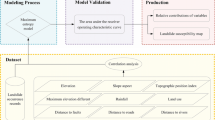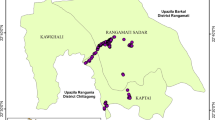Abstract
The motivation for this study was to clarify the factors that affect landslide occurrences at the national level in Japan and differences in the factors that result from landslide types. The factors that cause differences in the number of rainfall-triggered landslide disasters in 47 Japanese prefectures were examined using generalized linear models. The analysis was conducted for each of the three types (i.e., steep-slope failure, deep-seated landslide, and debris flow) of landslide disasters. For all types, the rainfall index and the number of landslide-prone areas were selected with positive coefficients while the accretionary complexes geological type was selected with negative coefficients. For steep-slope failure, forests and land for buildings were selected with negative and positive coefficients, respectively. For deep-seated landslide and debris flow, land use was seldom selected. Thus, the factors were found to have differed as a result of the landslide type. Because the number of landslides alters the fatalities and building damage in Japan, this study contributes to the prioritization of landslide countermeasures at the national level.





Similar content being viewed by others
References
Aditian A, Kubota T, Shinohara Y (2018) Comparison of GIS-based landslide susceptibility models using frequency ratio, logistic regression, and artificial neural network in a tertiary region of Ambon, Indonesia. Geomorphology 318:101–111. https://doi.org/10.1016/j.geomorph.2018.06.006
Aleotti P (2004) A warning system for rainfall-induced shallow failures. Eng Geol 73:247–265. https://doi.org/10.1016/j.enggeo.2004.01.007
Atkinson PM, Massari R (1998) Generalised Linear Modelling of susceptibility to Landsliding in the central Apennines, Italy. Comput Geosci 24:373–385. https://doi.org/10.1016/S0098-3004(97)00117-9
Ayalew L, Yamagishi H (2005) The application of GIS-based logistic regression for landslide susceptibility mapping in the Kakuda-Yahiko Mountains, Central Japan. Geomorphology 65:15–31. https://doi.org/10.1016/j.geomorph.2004.06.010
Baum RL, Godt JW (2010) Early warning of rainfall-induced shallow landslides and debris flows in the USA. Landslides 7:259–272. https://doi.org/10.1007/s10346-009-0177-0
Brardinoni F, Church M (2004) Representing the landslide magnitude–frequency relation: Capilano River basin, British Columbia. Earth Surf Process Landf 29:115–124. https://doi.org/10.1002/esp.1029
Budimir MEA, Atkinson PM, Lewis HG (2015) A systematic review of landslide probability mapping using logistic regression. Landslides 12:419–436. https://doi.org/10.1007/s10346-014-0550-5
Chae BG, Park HJ, Catani F, Simoni A, Berti M (2017) Landslide prediction, monitoring and early warning: a concise review of state-of-the-art. Geosci J 21:1033–1070. https://doi.org/10.1007/s12303-017-0034-4
Chigira M (2006) Prediction of potential landslide sites from the viewpoint of geology and geomorphology. Doboku Gakkai Ronbunshuu C 62:722–735. https://doi.org/10.2208/jscejc.62.722(inJapanese)
Conoscenti C, Ciaccio M, Caraballo-Arias NA, Gómez-Gutiérrez Á, Rotigliano E, Agnesi V (2015) Assessment of susceptibility to earth-flow landslide using logistic regression and multivariate adaptive regression splines: a case of the Belice River basin (western Sicily, Italy). Geomorphology 242:49–64. https://doi.org/10.1016/j.geomorph.2014.09.020
Emberson R, Kirschbaum D, Stanley T (2020) New global characterisation of landslide exposure. Nat Hazards Earth Syst Sci 20:3413–3424. https://doi.org/10.5194/nhess-20-3413-2020
Froude MJ, Petley DN (2018) Global fatal landslide occurrence from 2004 to 2016. Nat Hazards Earth Syst Sci 18:2161–2181. https://doi.org/10.5194/nhess-18-2161-2018
Fujiwara O, Yanagida M, Sanga T, Moriyama T (2005) Researches on tectonic uplift and denudation with relation to geological disposal of HLW in Japan. J Nuclear Fuel Cycle and Environment 11(2):113–124. https://doi.org/10.3327/jnuce.11.113 (in Japanese with English summary)
Gariano SL, Guzzetti F (2016) Landslides in a changing climate. Earth Sci Rev 162:227–252. https://doi.org/10.1016/j.earscirev.2016.08.011
Genet M, Kokutse N, Stokes A, Fourcaud T, Cai X, Ji MS (2008) Root reinforcement in plantations of Cryptomeria japonica D. Don: effect of tree age and stand structure on slope stability. For Ecol Manag 256:1517–1526. https://doi.org/10.1016/j.foreco.2008.05.050
Geological Survey of Japan (2015) Seamless digital geological map of Japan 1: 200,000. May 29, 2015 version. Geological Survey of Japan, National Institute of Advanced Industrial Science and Technology
Geological Survey of Japan (2022) Geology of Japan. https://www.gsj.jp/en/education/geomap-e/geology-e.html. Accessed 22 March 2022
Guzzetti F, Gariano SL, Peruccacci S, Brunetti MT, Marchesini I, Rossi M, Melillo M (2020) Geographical landslide early warning systems. Earth Sci Rev 200:102973. https://doi.org/10.1016/j.earscirev.2019.102973
Haque U, Blum P, Da Silva PF, Andersen P, Pilz J, Chalov SR et al (2016) Fatal landslides in Europe. Landslides 13:1545–1554. https://doi.org/10.1007/s10346-016-0689-3
Hayashi S, Mizuno H, Okamoto A, Hiruma M, Kondo R (2013) Activities of the ESCAP/WMO Typhoon Committee regarding sediment-related disaster prevention using non-structural measures, based on Japanese SABO technology. Trop Cyclone Res Rev 2:55–64. https://doi.org/10.6057/2013TCRR01.06
Horiguchi T, Richefeu V (2020) Post-analysis simulation of the collapse of an open sabo dam of steel pipes subjected to boulder laden debris flow. Int J Sediment Res 35:621–635. https://doi.org/10.1016/j.ijsrc.2020.05.002
Hubert C (2004) Sabo check dams: mountain protection systems in Japan. Int J River Basin Manag 2:301–307. https://doi.org/10.1080/15715124.2004.9635240
Hungr O, Leroueil S, Picarelli L (2014) The Varnes classification of landslide types, an update. Landslides 11:167–194. https://doi.org/10.1007/s10346-013-0436-y
Japan Meteorological Agency (2022) Update of climatological normal. https://www.jma.go.jp/jma/press/2103/24a/210324_heinenchi.html. Accessed 9 Aug 2022
Japan Meteorological Agency (2023) Download historical metrological data. https://www.data.jma.go.jp/gmd/risk/obsdl/index.php. Accessed 25 May 2023
Japan Sabo Association (2015) Handbook of Sabo 2014 Edition (in Japanese)
Jia G, Alvioli M, Gariano SL, Marchesini I, Guzzetti F, Tang Q (2021) A global landslide non-susceptibility map. Geomorphology 389:107804. https://doi.org/10.1016/j.geomorph.2021.107804
Lee CT, Huang CC, Lee JF, Pan KL, Lin ML, Dong JJ (2008) Statistical approach to storm event-induced landslides susceptibility. Nat Hazards Earth Syst Sci 8:941–960. https://doi.org/10.5194/nhess-8-941-2008
Liang WL, Kosugi K, Mizuyama T (2009) A three-dimensional model of the effect of stemflow on soil water dynamics around a tree on a hillslope. J Hydrol 366:62–75. https://doi.org/10.1016/j.jhydrol.2008.12.009
Lin Q, Lima P, Steger S, Glade T, Jiang T, Zhang J, Liu T, Wang Y (2021) National-scale data-driven rainfall landslide susceptibility mapping for China by accounting for incomplete landslide data. Geosci Front 12:101248. https://doi.org/10.1016/j.gsf.2021.101248
Lusiana N, Shinohara Y (2022) The Role of Citrus Groves in Rainfall-Triggered Landslide Hazards in Uwajima. Japan Water 14:2113. https://doi.org/10.3390/w14132113
Maleki M, Mir Mohammad Hosseini SM (2022) Assessment of the Pseudo-static seismic behavior in the soil nail walls using numerical analysis. Innov Infrastruct Solut 7:262. https://doi.org/10.1007/s41062-022-00861-5
Maleki M, Khezri A, Nosrati M, Mir Mohammad Hosseini SM (2023) Seismic amplification factor and dynamic response of soil-nailed walls. Model Earth Syst Environ 9:1181–1198. https://doi.org/10.1007/s40808-022-01543-y
Millán-Arancibia C, Lavado-Casimiro W (2023) Rainfall thresholds estimation for shallow landslides in Peru from gridded daily data. Nat Hazards Earth Syst Sci 23:1191–1206. https://doi.org/10.5194/nhess-23-1191-2023
MLIT (2022a) Number of sediment-related disasters in 2018. https://www.mlit.go.jp/report/press/sabo02_hh_000068.html. Accessed 23 March 2022a
MLIT (2022b) Digital national land information. https://nlftp.mlit.go.jp/ksj/index.html. Accessed 22 March 2022b
Modugno S, Johnson SCM, Borrelli P, Alam E, Bezak N, Balzter H (2022) Analysis of human exposure to landslides with a GIS multiscale approach. Nat Hazards 112:387–412. https://doi.org/10.1007/s11069-021-05186-7
Nadim F, Kjelstad O, Peduzzi P, Herold C, Jaedicke C (2006) Global landslide and avalanche hotspots. Landslides 3:159–173. https://doi.org/10.1007/s10346-006-0036-1
Nakaya H, Takiguchi S, Kanazawa A (2020) Reality of cliff failure disaster. Technical Note of National Institute for Land and Infrastructure Management No.1122.
Okada Y, Cai F, Kurokawa U (2023) Changes in slope stability over the growth and decay of Japanese cedar tree roots. Forests 14:256. https://doi.org/10.3390/f14020256
Osanai N, Shimizu T, Kuramoto K, Kojima S, Noro T (2010) Japanese early-warning for debris flows and slope failures using rainfall indices with Radial Basis Function Network. Landslides 7:325–338. https://doi.org/10.1007/s10346-010-0229-5
Pereira S, Santos PP, Zêzere JL, Tavares AO, Garcia RAC, Oliveira SC (2020) A landslide risk index for municipal land use planning in Portugal. Sci Total Environ 735:139463. https://doi.org/10.1016/j.scitotenv.2020.139463
Pradhan B (2013) A comparative study on the predictive ability of the decision tree, support vector machine and neuro-fuzzy models in landslide susceptibility mapping using GIS. Comput Geosci 51:350–365. https://doi.org/10.1016/j.cageo.2012.08.023
QGIS.org (2023) QGIS Geographic Information System. QGIS Association. http://www.qgis.org. Accessed 25 May 2023
R Core Team (2021) R: A language and environment for statistical computing. R Foundation for Statistical Computing. https://www.R-project.org/. Accessed 25 May 2023
Reichenbach P, Rossi M, Malamud BD, Mihir M, Guzzetti F (2018) A review of statistically-based landslide susceptibility models. Earth Sci Rev 180:60–91. https://doi.org/10.1016/j.earscirev.2018.03.001
Sabo and Landslide Technical Center (2023) The Reality of Sediment-related Disasters. https://www.stc.or.jp/?page_id=122. Accessed 25 May 2023
Salvati P, Petrucci O, Rossi M, Bianchi C, Pasqua AA, Guzzetti F (2018) Gender, age and circumstances analysis of flood and landslide fatalities in Italy. Sci Total Environ 610–611:867–879. https://doi.org/10.1016/j.scitotenv.2017.08.064
Sawano S, Komatsu H, Suzuki M (2005) Differences in annual precipitation amounts between forested area, agricultural area, and urban area in Japan. J Jpn Soc Hydrol Water Resour 18:435–440. https://doi.org/10.3178/jjshwr.18.435 (in Japanese with English summary)
Schmidt KM, Roering JJ, Stock JD, Dietrich WE, Montgomery DR, Schaub T (2001) The variability of root cohesion as an influence on shallow landslide susceptibility in the Oregon Coast Range. Can Geotech J 38:995–1024. https://doi.org/10.1139/t01-031
Shinohara Y, Komatsu H (2016) The recent trend in annual death toll by landslide disasters in Japan. J Jap Soc Erosion Control Eng 68(5):3–9. https://doi.org/10.11475/sabo.68.5_3 (in Japanese with English summary)
Shinohara Y, Kume T (2022) Changes in the factors contributing to the reduction of landslide fatalities between 1945 and 2019 in Japan. Sci Total Environ 827:154392. https://doi.org/10.1016/j.scitotenv.2022.154392
Statistics Bureau of Japan (2015) Japan Statistical Yearbook 2016. https://www.stat.go.jp/data/nenkan/65nenkan/index.html. Accessed 27 May 2023
Statistics Bureau of Japan (2021) Japan Statistical Yearbook 2022. https://www.stat.go.jp/data/nenkan/71nenkan/index.html. Accessed 27 May 2023
Steger S, Mair V, Kofler C, Pittore M, Zebisch M, Schneiderbauer S (2021) Correlation does not imply geomorphic causation in data-driven landslide susceptibility modelling–Benefits of exploring landslide data collection effects. Sci Total Environ 776:145935. https://doi.org/10.1016/j.scitotenv.2021.145935
Stokes A, Atger C, Bengough AG, Fourcaud T, Sidle RC (2009) Desirable plant root traits for protecting natural and engineered slopes against landslides. Plant Soil 324:1–30. https://doi.org/10.1007/s11104-009-0159-y
Uchida T, Nishiguchi Y (2011) An analysis for characteristics of recent sediment disasters using relatively long-term historical data. J Jap Soc Erosion Control Eng 64:58–64. https://doi.org/10.11475/sabo.64.2_58. (in Japanese)
Uchida T, Nishimoto H, Osanai N, Shimizu T (2009) Countermeasures for sediment-related disasters in Japan using hazard maps. Int J Erosion Control Eng 2:46–53. https://doi.org/10.13101/ijece.2.46
UNDRR/CRED (2020) Human cost of disaster: An overview of the last 20 years 2000–2019. https://reliefweb.int/report/world/human-cost-disasters-overview-last-20-years-2000-2019. Accessed 30 Sept 2021
Van Den Eeckhaut M, Hervás J (2012) State of the art of national landslide databases in Europe and their potential for assessing landslide susceptibility, hazard and risk. Geomorphology 139–140:545–558. https://doi.org/10.1016/j.geomorph.2011.12.006
Varnes DJ (1978) Slope movement types and processes. In: Schuster RL, Krizek RJ (eds) Landslides, analysis and control, special report 176: transportation research board. National Academy of Sciences, Washington, pp 11–33
Wakita K (2013) Geology and tectonics of Japanese islands: a review–the key to understanding the geology of Asia. J Asian Earth Sci 72:75–87. https://doi.org/10.1016/j.jseaes.2012.04.014
Yamase K, Todo C, Torii N, Tanikawa T, Yamamoto T, Ikeno H, Ohashi M, Dannoura M, Hirano Y (2021) Dynamics of soil reinforcement by roots in a regenerating coppice stand of Quercus serrata and effects on slope stability. Ecol Eng 162:106169. https://doi.org/10.1016/j.ecoleng.2021.106169
Yano A, Shinohara Y, Tsunetaka H, Mizuno H, Kubota T (2019) Distribution of landslides caused by heavy rainfall events and an earthquake in northern Aso Volcano, Japan from 1955 to 2016. Geomorphology 327:533–541. https://doi.org/10.1016/j.geomorph.2018.11.024
Acknowledgements
This work was supported by Japan Society for the Promotion of Science (JSPS) KAKENHI Grant Number JP21K04590. We thank Martha Evonuk, PhD, and Leonie Seabrook, PhD, from Edanz, for editing a draft of this manuscript.
Funding
This work was supported by Japan Society for the Promotion of Science (JSPS) KAKENHI Grant Number JP21K04590.
Author information
Authors and Affiliations
Contributions
All authors contributed to the study conception and design. Material preparation, data collection and analysis were mainly performed by Yuta Watanabe and partly by Yoshinori Shinohara. The first draft of the manuscript was written by Yoshinori Shinohara. All authors read and approved the final manuscript.
Corresponding author
Ethics declarations
Conflict of interest
The authors have no competing interests to disclose.
Additional information
Publisher's Note
Springer Nature remains neutral with regard to jurisdictional claims in published maps and institutional affiliations.
Supplementary Information
Below is the link to the electronic supplementary material.
Rights and permissions
Springer Nature or its licensor (e.g. a society or other partner) holds exclusive rights to this article under a publishing agreement with the author(s) or other rightsholder(s); author self-archiving of the accepted manuscript version of this article is solely governed by the terms of such publishing agreement and applicable law.
About this article
Cite this article
Shinohara, Y., Watanabe, Y. Differences in factors determining landslide hazards among three types of landslides in Japan. Nat Hazards 118, 1689–1705 (2023). https://doi.org/10.1007/s11069-023-06075-x
Received:
Accepted:
Published:
Issue Date:
DOI: https://doi.org/10.1007/s11069-023-06075-x




